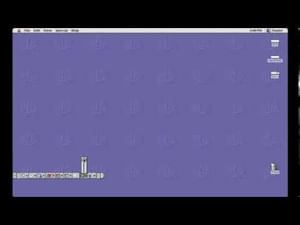
- Sheepshaver 8 bit color mac os#
- Sheepshaver 8 bit color 720p#
- Sheepshaver 8 bit color install#
- Sheepshaver 8 bit color drivers#
- Sheepshaver 8 bit color Pc#
Sheepshaver 8 bit color install#
I downloaded many of them from an abadonware website and install on my vMac: What would a computer be without some games? Well, there were plenty of games, both text and graphics, for the Macintosh Plus.


In the end, I used a stereo audio loopback cable that connects the speaker output port to the line-in port, and the audio was recorded perfectly.
Sheepshaver 8 bit color drivers#
It could be due to Windows 8, or due to the Mac Mini Bootcamp drivers for Windows. I also tried a suggestion of recording from the microphone using the Stereo Mix option, only to find that no such option exists on my machine. This error is mentioned in the official website, with no solution available. Although CamStudio supports recording of audio output from the speaker, attempting to select Option > Record audio from speakers results in an error message “WaveoutGetSelectControl() failed.”. The above clips were captured using CamStudio for Windows.
Sheepshaver 8 bit color Pc#
The PC did not come bundled with sound hardware, other than the PC speaker, until years later. It is amazing considering that the audio on a Macintosh Plus is generated using a 8-bit DAC at 22kHz sampling rate. See the following video and notice how the application says “Goodbye” when you choose to quit. After much effort I managed to grab a working version and make the Plus speak. Surprisingly there is a text-to-speech tool called Voice Box available for the Plus. I’m using Quadra 900 ROM MacROMan/1991-10 - 420DBFF3 - Quadra 700&900 & PB140&170.This is probably very hard to find nowadays – MacroMind MusicWorks allows you to compose songs:Īnd MacroMind VideoWorks allows you to design nice animations that are playable on the Plus:Īnother VideoWorks video, this time with audio: I downloaded a HD disk image for 7.5.5 here MacOS 7.5.5 (English) (Clean Copy) - Macintosh Repository My config is mostly defaults, I changed screen, extfs, disk, and modelid (for Quadra 900, to match my ROM). After first boot, I needed to use Monitors Control Panel to change from monochrome to thousands of colors. The installer should see the new image and finish the installation. This gives you a list of mounted drives, identify the CD-ROM, prob ide1-cd0 You need shut it down, change the boot flag to point towards the HDD instead of CD, then “swap” cd images like this: After the first disk completes installing, the guest will try to restart but boot from the CD again. Has a USB tablet pointing device -device usb-tablet (this helps smooth out the mouse pointer capture, making so it doesn’t get caught on the edges of the host window/screen)Īdd this to the list when mounting an image containing software/during installation:įor OS X, I waited hours and hours working off two install CD images.
Sheepshaver 8 bit color 720p#
Has a VGA graphics card with 64 MB vram -device VGA,edid=on,vgamem_mb=64,xres=1280,yres=720ĭisplay res 720p 32-bit color -g 1280x720x32īoot from HD image -boot c (swap for -boot d when booting from install media) USB-friendly Mac with G4 processor -M mac99,via=pmu -cpu g4 QEMU PowerPC translation with acceleration, required bios: qemu-system-ppc -accel tcg -L pc-bios Qemu-system-ppc -accel tcg -L pc-bios -M mac99,via=pmu -cpu g4 -m 1024 -hda diskx.img -device VGA,edid=on,vgamem_mb=64,xres=1280,yres=720 -g 1280x720x32 -boot c -device usb-tablet
The OS 9 install went extremely quickly thanks to an image called OS9Lives, which is set up to directly clone a known working disk with staple apps already installed to your bootable disk image.įor booting the OS X guest, I found the following works best: Installers are readily available out there gestures but I won’t link here just in case there are legal issues. Neither guest OS has working sound, but there’s some effort on the part of the community to fix this with the qemu-screamer fork but I figured I should try whatever QEMU version was native to arm64 before trying this one that seems to be focused on x86 Windows and Mac. Networking is configured automatically! I was able to browse using frogfind, which strips away elements from sites and loads a text-only version friendly to retro computers/defunct browsers. There’s some info in the emaculation forum about installing a usb-tablet extension, but that didn’t work for me and instead leaves the cursor immobile.
Sheepshaver 8 bit color mac os#
Mac OS 9 does not respond well to the Reform trackball, and that makes using it a terrible experience. The guest thinks it’s a 900 MHz PPC G4, but I’ve never used a G4 that felt this slow before! I don’t think there’s a way to allocate more CPU resources, but I could be wrong. In OS X, Activity Monitor shows the virtual processor basically fully utilized, while on the host, I barely get 115% CPU utilization for the QEMU process. I’ve played around with some of the optional commands that I thought would help out but I’m unsure they’re doing anything (see below for my recommended config). Performance is very slow in either OS 9 or OS X.


 0 kommentar(er)
0 kommentar(er)
